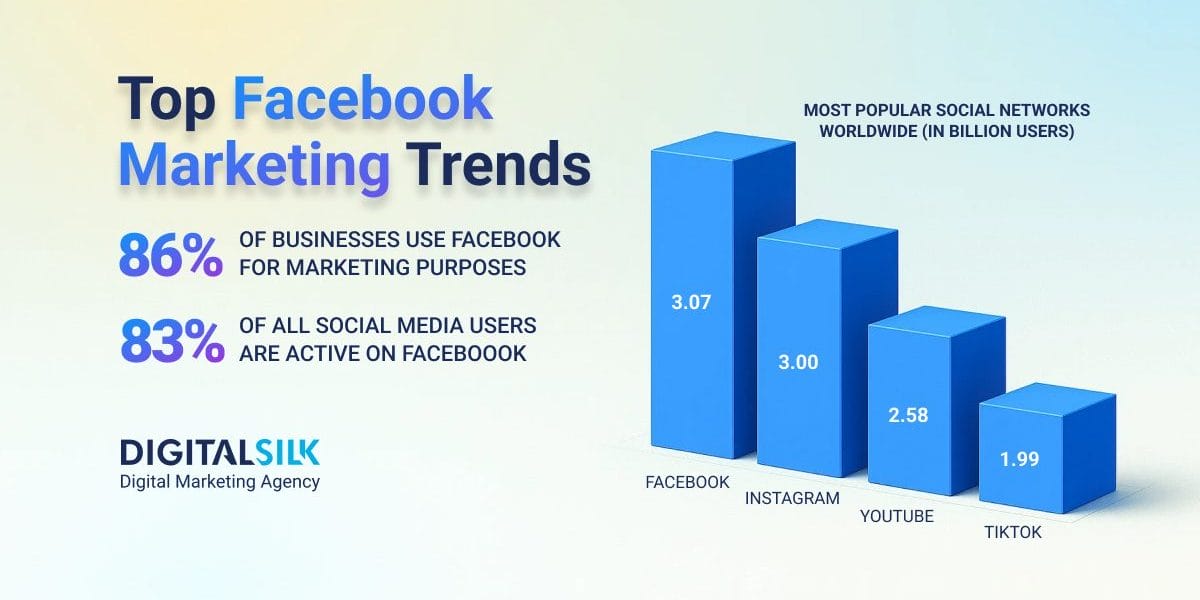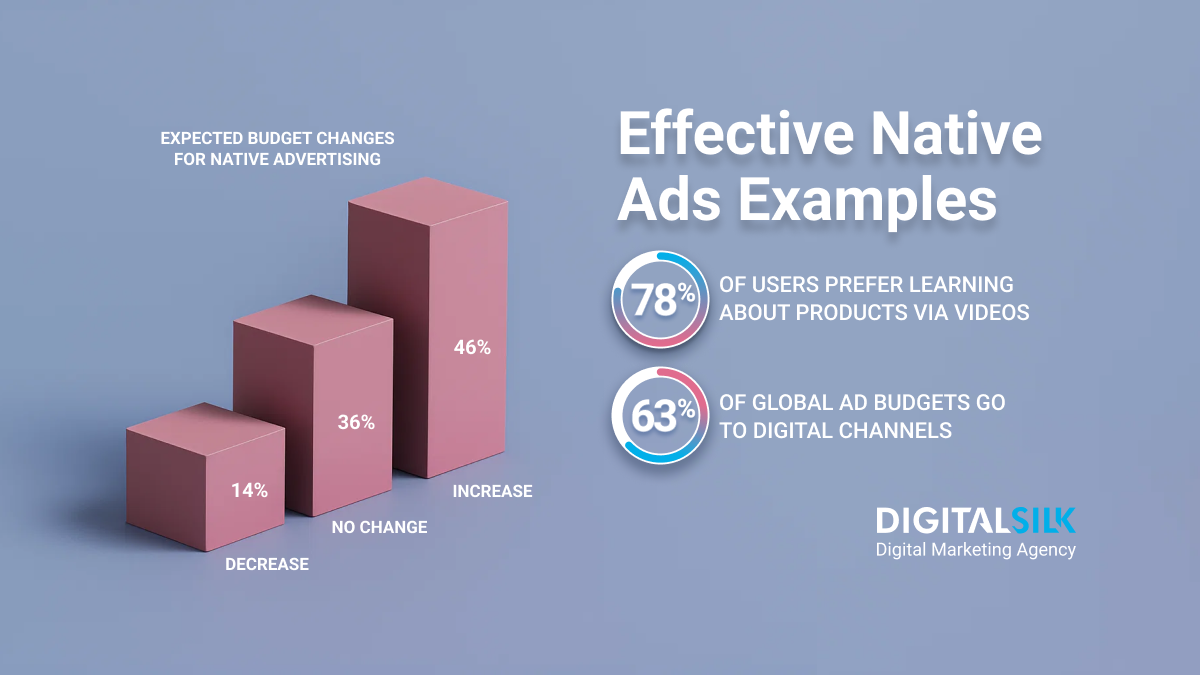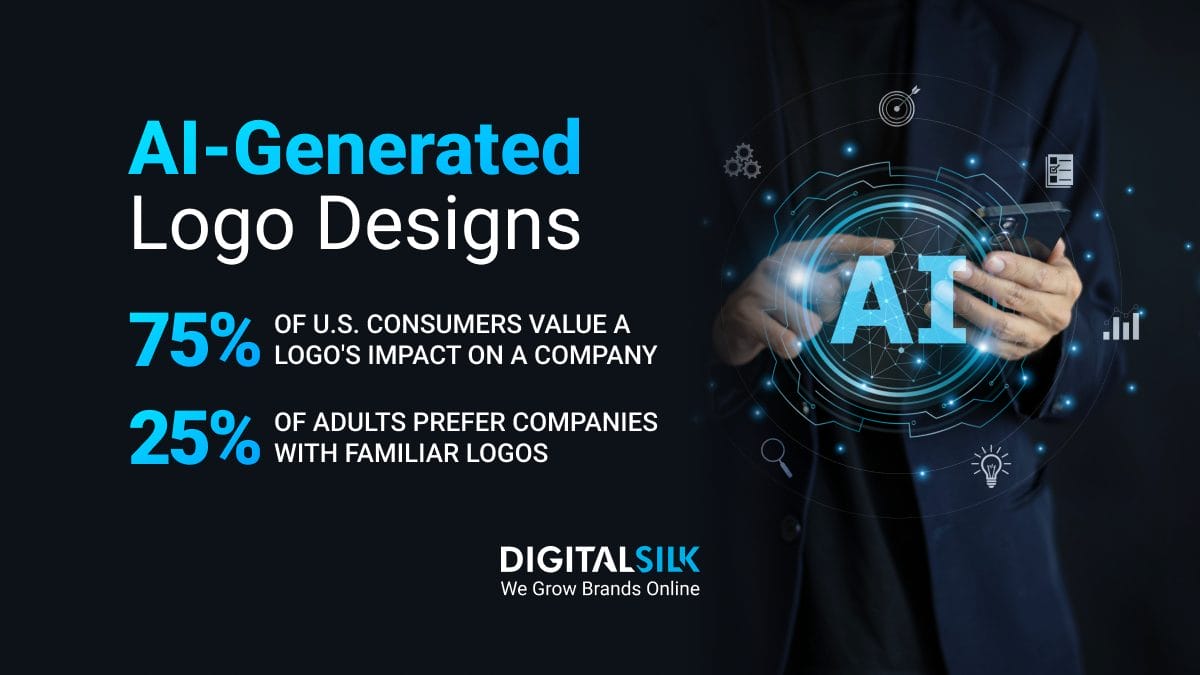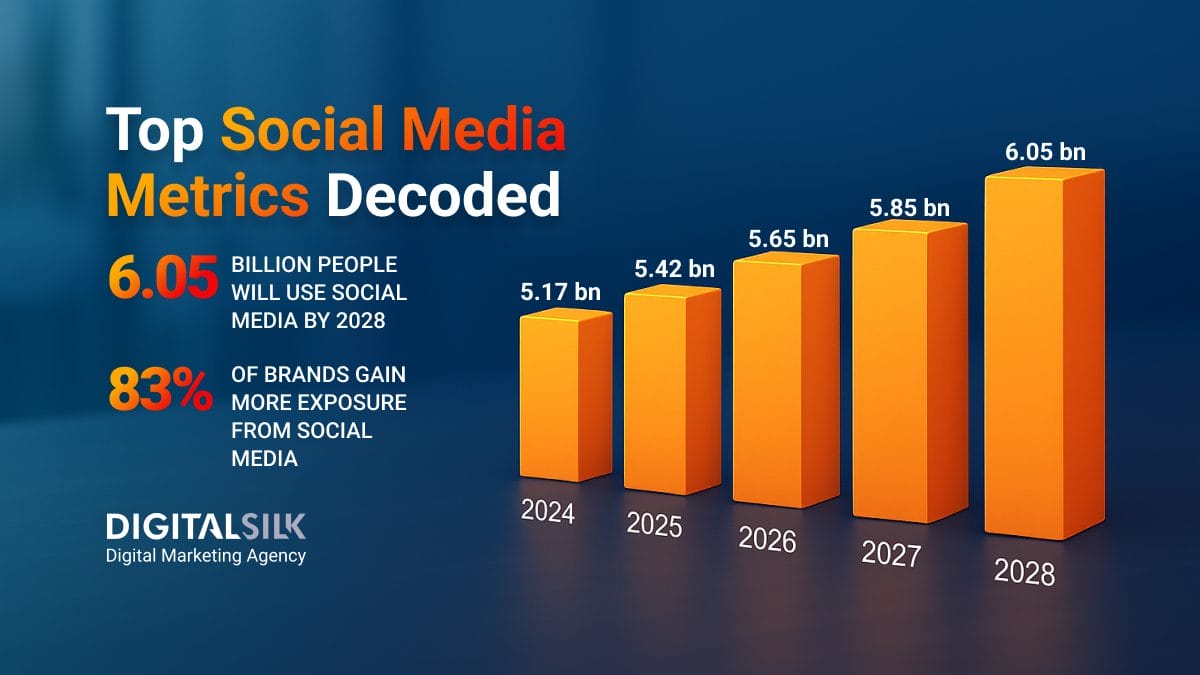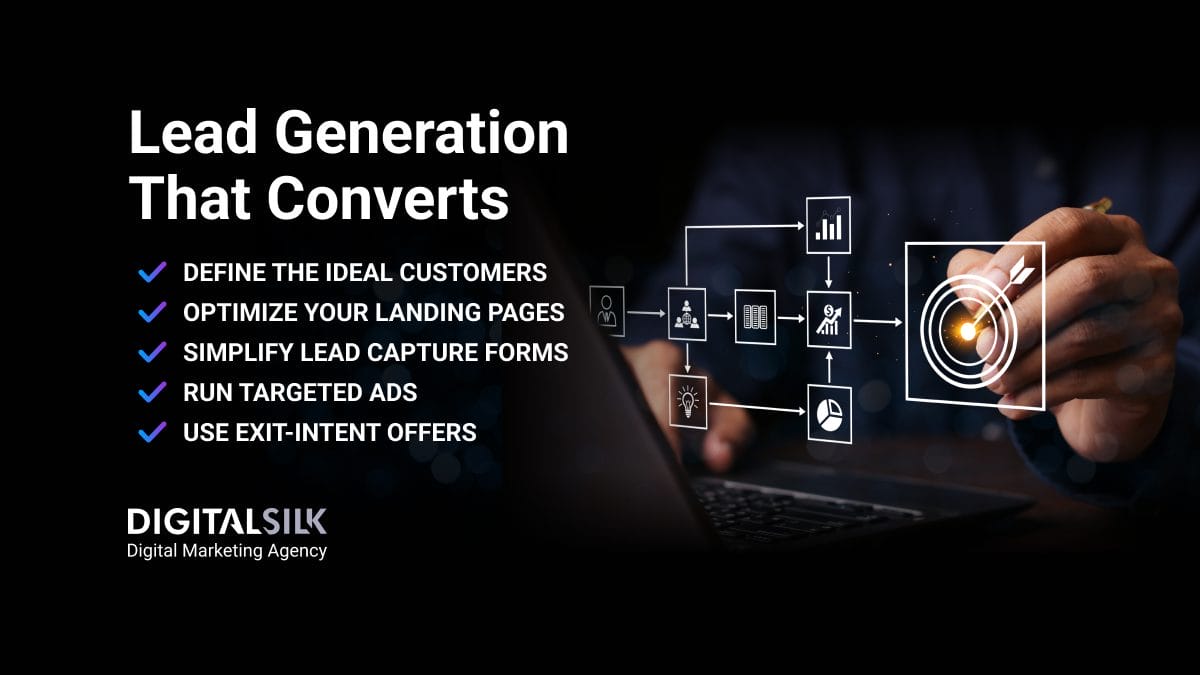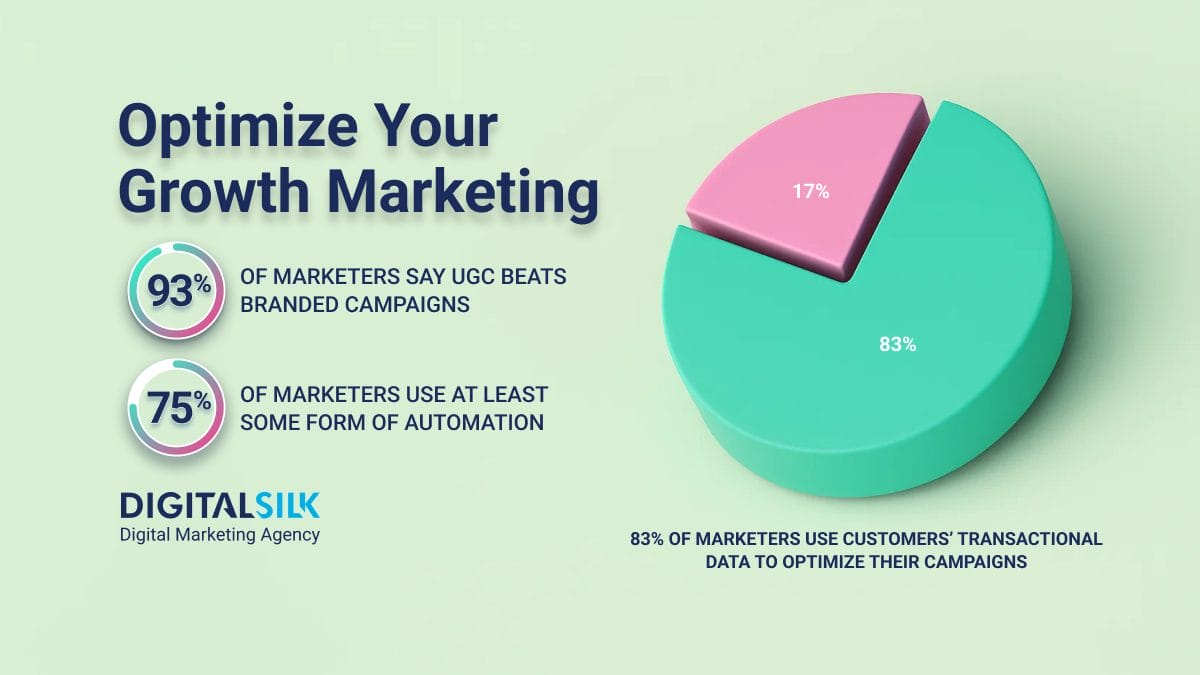Facebook Marketing Strategies: Key Highlights
-
Track insights: Use audience signals, comments and watch time to uncover motivations and sharpen messaging in real time.
-
Strategy begins with structure: Define your core audience segments, organize creative formats and measure with precision before scaling campaigns.
-
Experimental creativity: Continual testing across formats such as reels, carousels and lives reveals what captures attention and drives real engagement.
Why do so many companies pour marketing resources into new platforms while ignoring the biggest social network where 3.07 billion people already spend their time?
Facebook remains unmatched in scale, influence and data-driven potential, yet many business leaders treat it as background noise in their marketing mix.
The truth is, Facebook’s real advantage isn’t its size but its ability to connect brands with audiences through intent, behavior and authentic conversation.
Brands that understand this are using Facebook to identify what truly motivates their audiences, refine messaging in real time and build relationships that translate into long-term value.
Below, we’ll uncover 15 Facebook marketing strategies that show how to turn everyday engagement into lasting impact.
Effective Facebook Marketing Strategies 2025: A Core Framework
Before you apply the 15 Facebook marketing strategies outlined in this post, make sure you align these three pillars so the final execution delivers resuls:
- Audience insights: Define 2–3 primary segments with specific pains, desired outcomes and offers they’ll get.
- Creative system: Standardize the formats, such as reels, carousels, short posts or livestreams, along with strategies for testing hooks, offers and CTAs weekly.
- Measurement criteria: Agree on KPIs per funnel stage, adopt Conversions API (CAPI) alongside Pixel and run at least one ongoing experiment (creative or audience) at all times.
15 Best Facebook Marketing Strategies For 2025 & Beyond
With 83% of all social media users active on Facebook, the question isn’t whether your audience is there, but how well your brand meets them in that space.
Every shift in algorithm and audience behavior creates new openings for those willing to test, analyze and adapt to what truly resonates.
The following strategies for Facebook marketing explore what’s working now and how to position your brand for sustained growth in 2025 and beyond:
1. Define Clear Marketing Goals
86% of marketers use Facebook, which means participation alone adds little advantage, but the edge comes from goal clarity tied to business outcomes.
The platform can drive very different results depending on what you ask of it, so vague goals invite vanity metrics and scattered marketing spending.
The most effective Facebook marketing strategies require defined goals that shape creative direction, budget decisions and performance measurement from the start:
- Set one clear objective for each campaign period so every effort points toward a single measurable outcome.
- Translate goals into specific, measurable, achievable, relevant and time-bound (SMART) targets to define exactly what success looks like and when it should be reached.
- Create a measurement plan early with defined conversion events, attribution models and tracking methods everyone trusts.
- Watch early indicators like click-through rate, add-to-cart rate or engagement depth to spot friction points before results decline.
- Choose metrics that match the stage of the customer journey you’re trying to influence, from awareness to conversion.
- Run a short pre-mortem before launch to identify risks such as tracking gaps, slow page load times or weak offers and resolve them early.
- Review progress consistently to identify trends, refine tactics and document insights that improve future performance.
2. Optimize Your Facebook Business Page
Facebook drives more traffic for marketers than any other social platform, with 42% of marketers naming it their top source.
Yet many pages still look like unfinished profiles rather than purposeful brand assets.
Every element of your business page should work together to inform, guide and engage, so updating your business profile is central to effective Facebook marketing strategies for 2025 and beyond:
- Use consistent brand visuals: Choose a profile image and cover photo that represent your brand identity and are instantly recognizable. Consistency builds familiarity and trust.
- Complete your “About” section: Write a short, precise description of what your business offers, include relevant keywords and keep contact information accurate.
- Add a call-to-action button: Use options such as “Book Now,” “Shop” or “Contact” to direct visitors toward a specific next step.
- Verify your page: A verification badge adds authenticity and helps potential customers feel confident engaging with your brand.
- Align visuals and messaging with current goals: Update imagery, pinned content and tabs to reflect live campaigns and evolving priorities.
- Assign clear page roles: Give appropriate access levels to those managing content or customer interactions to maintain control, security and consistency in communication.
For example, Fenty Beauty’s Facebook page shows how a well-optimized business page functions as a complete brand experience.
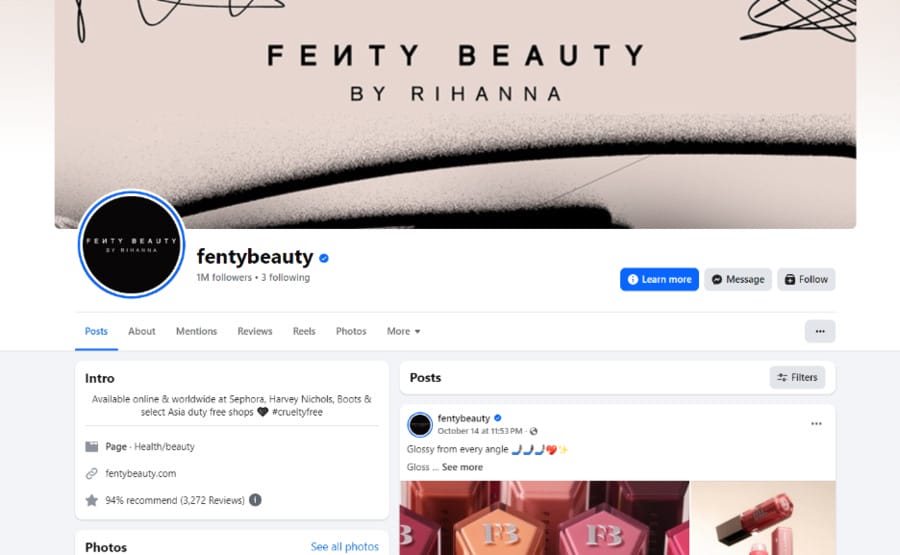
The logo and cover image reinforce brand recognition, while the “About” section is concise and informative, focusing on accessibility and distribution.
The verified badge and clear “Learn More” button build trust and offer direction, showing how small details can make a page feel both professional and approachable.
3. Identify And Segment Your Target Audience
Facebook’s scale only matters if you know who within that audience you’re speaking to.
In the U.S., 78% of women and 61% of men use the platform, while engagement peaks among 30–49-year-olds at 78%.
Those numbers point to influence and buying power but also highlight how fragmented attention really is.
Facebook Audience Insights helps you uncover what drives engagement, showing where your content connects and where it falls flat:
- Demographics overview: See the age, gender and location breakdowns of your followers to identify which groups are most engaged.
- Popular with your followers: Discover which content, pages and creators your audience responds to most so you can shape ideas around what’s working now.
- Views over time: Track how engagement changes after publishing to spot patterns in timing and relevance.
- View rate: Measure how many viewers stay versus scroll past your videos to assess the strength of your openings.
- Retention: See where viewers lose interest to refine pacing, structure or messaging for better performance.
- Comparative insights: Compare new posts with older ones to identify what consistently holds attention and where to improve.
Here’s a brief overview of the Facebook Audience Insights dashboard:
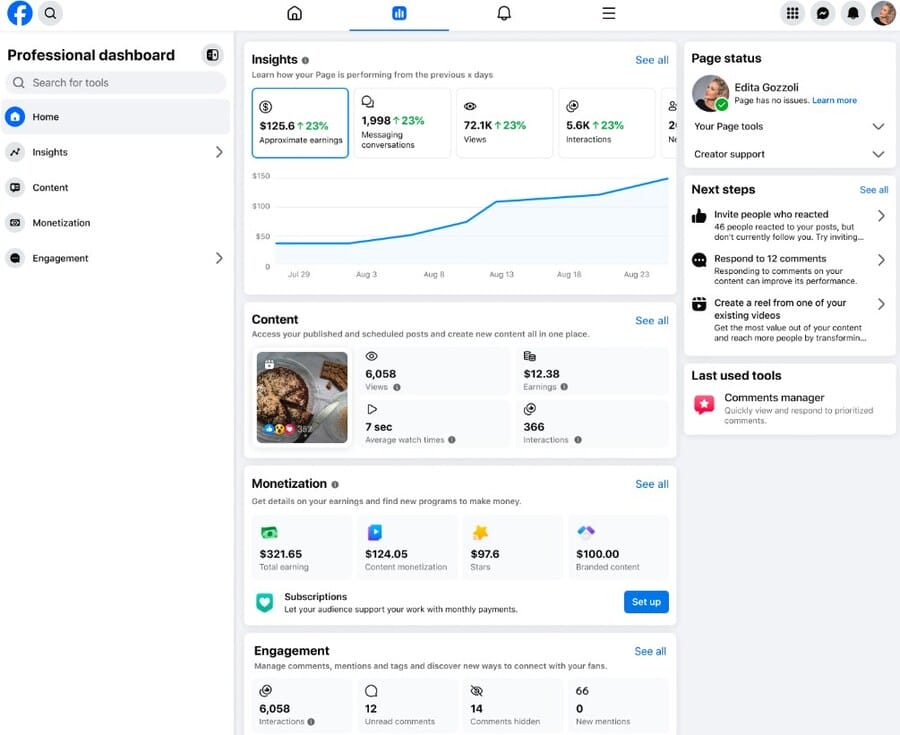
From there, use what you’ve learned to shape how you segment and communicate with different groups across your Facebook marketing strategies:
- Segment audiences based on how they engage, as people who comment, share or watch through are far more valuable than passive followers.
- Build tailored campaigns for each segment so your tone, offers and creative direction align with what motivates them most.
- Explore lookalike audiences to reach new users who share characteristics with your most responsive followers while maintaining relevance.
- Review competitors’ engagement to identify the conversations that resonate in your industry and where you can fill the gaps.
- Revisit your segments regularly to refine targeting as interests and behaviors evolve.
4. Set Up Your Facebook Ads Account
In the U.S., 45% of consumers use Facebook to discover and research products, placing it second among all social platforms for product exploration.
Reaching that audience efficiently requires a properly configured ad account that keeps campaigns organized, accurate and easy to manage.
In marketing strategies for Facebook pages, this step ensures your advertising operates smoothly and produces insights you can trust.
Start by setting up your account with these key elements in place:
- Use Meta Business Suite for control: Manage all assets from one dashboard where you can organize pages, ad accounts and permissions without mixing personal and business profiles.
- Create a dedicated ad account: Link it directly to your Facebook page for unified reporting, consistent billing and transparent performance tracking.
- Add verified payment methods: Enter billing information early to avoid campaign interruptions and keep spending aligned with your marketing goals.
- Integrate Meta Pixel: Install it on your website to track user actions, measure conversions and refine targeting through real behavioral data.
- Define clear access roles: Assign admin, editor and advertiser permissions carefully to maintain both efficiency and security.
- Keep account information accurate: Review currency, time zone and business details regularly to ensure smooth operation and dependable reporting.
The Facebook Ads Manager dashboard provides a complete overview of your advertising activity in one place, so you can create, manage and analyze campaigns, ad sets and individual ads.
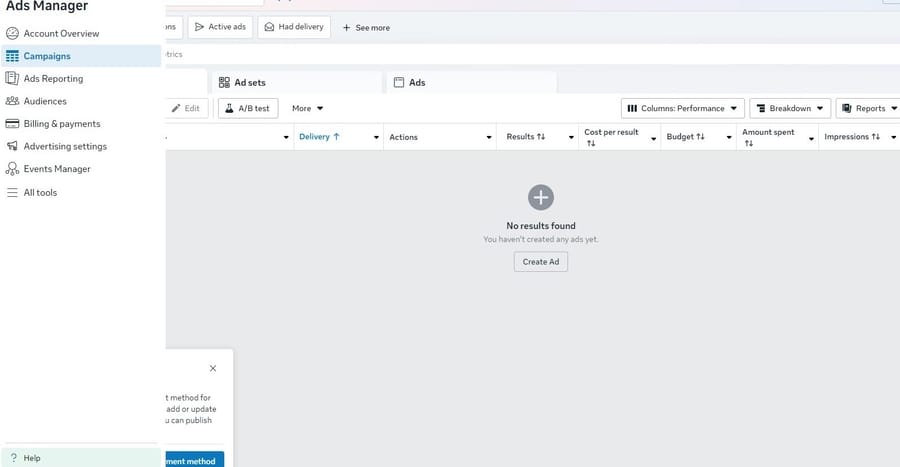
The left-hand menu gives direct access to core functions like campaigns, audiences, billing and performance reports, while the main workspace displays delivery, budget, reach and cost metrics.
5. Create A Data-Driven Publishing Schedule
Consistent posting means little without understanding when your audience is most likely to engage.
Engagement tends to rise during the week, with Mondays through Fridays delivering the best results and Sundays seeing the lowest activity.
| DAY OF THE WEEK | TIME TO POST |
| Mondays | 6 – 9 p.m. |
| Tuesdays | 5 p.m. – midnight |
| Wednesdays | midnight – 3 a.m. or 5 p.m. – midnight |
| Thursdays | midnight – 3 a.m. or 4 p.m. – midnight |
| Fridays | midnight – 3 a.m. or 5 – 7 p.m. |
| Saturdays | midnight – 5 a.m. or 5 – 7 p.m. |
| Sundays | midnight – 3 a.m. or 3 p.m. – midnight |
When Facebook marketing strategies for companies are in sync with audience habits, your content is more likely to surface where and when it matters.
To develop a schedule that supports lasting engagement, keep these points in mind:
- Use Facebook analytics to identify audience activity: Post during the hours when followers are most active to increase visibility and interaction.
- Plan posts ahead of time: Map out a weekly or monthly calendar so content aligns with campaigns and publishing stays consistent.
- Consider time zones: If your audience spans multiple regions, schedule posts during overlapping windows of peak activity.
- Stay consistent with frequency: Publish regularly but with purpose, allowing enough time for each post to gain traction before the next.
- Schedule posts through Meta’s publishing tools: Use Meta Business Suite or Creator Studio to automate posting and maintain steady timing.
6. Use A Mix Of Media Content
Different formats drive different types of engagement and Facebook rewards pages that create a diverse content experience.
The average number of Facebook posts per day is 1.73, with link posts generating the highest engagement rate at 2.45% compared to the post reach.
But other formats shouldn’t be overlooked either, including visuals, videos and live streams as they all contribute to how people interact and build familiarity with your brand.
Any Facebook marketing strategies for 2025 and beyond should use all elements to maintain interest and build a comprehensive and more engaging brand presence.
To create a balanced content mix, focus on the following:
- Blend link posts with visuals: Alternate between informative link posts and high-quality images that attract attention in the feed.
- Use video to add depth: Share short clips for quick updates and longer videos for storytelling or product highlights. Make the first few seconds compelling to capture attention early.
- Go live when it adds value: Stream launches, interviews or Q&A sessions to connect in real time and create genuine interaction.
- Publish with Instant Articles: Use them for longer written content to improve load time and keep mobile users engaged.
- Add captions to videos: Since many viewers watch without sound, captions help deliver the full message clearly.
- Maintain consistent visuals: Ensure images, thumbnails and color schemes align with your brand identity for a cohesive experience.
Among Facebook real estate marketing strategies, Zillow exemplifies how to keep property content both inviting and effective.
The brand uses short vertical videos, natural lighting and conversational captions to show how specific properties can enhance daily living.
By combining these visuals with direct links and consistent hashtags, Zillow creates an easy flow from interest to inquiry, inviting viewers to explore homes that match their lifestyle.
7. Engage With Your Audience Consistently
Sustainable engagement grows from ongoing interaction between your brand and its followers.
The most effective marketing strategies on Facebook treat every comment, reaction and review as an opportunity to listen and respond with intention.
When people see a brand that participates in conversation, answers questions and acknowledges feedback, they develop a stronger sense of connection and trust.
To keep engagement consistent and purposeful:
- Reply often: Dedicate time each day to read and respond to comments, questions and reviews.
- Show appreciation: Thank users for positive feedback and interactions to reinforce goodwill.
- Handle criticism constructively: Respond thoughtfully to concerns to demonstrate transparency and care.
- Ask meaningful questions: Encourage interaction by prompting followers to share opinions or experiences.
- Stay aware of mentions: Monitor discussions that involve your brand and contribute where relevant.
For instance, Peloton demonstrates how engagement fuels community in fitness marketing strategies for Facebook.
By inviting followers to share their favorite instructors, the brand transforms a simple post into a collective moment of appreciation.
This approach keeps interaction genuine and reminds audiences that the brand’s value lives as much in its people as in its product.
8. Leverage Facebook Messenger And Chatbots
Many customers see Facebook as a customer service channel as much as a social one.
55% of social media users go there to resolve service-related issues, with 58% of consumers saying that brand responses on social media are important to them.
At the same time, expectations are high, with 32% of users wanting a reply within an hour, which means fast, automated communication is a necessity rather than an advantage.
Using Messenger and chatbots as part of your marketing strategies on Facebook helps maintain consistent, timely engagement with customers.
These tools handle everyday questions, provide quick guidance and ensure your brand’s available even when your team isn’t online.
To make Messenger and chatbots work effectively:
- Automate common questions: Provide instant answers to frequent topics like pricing, hours or shipping.
- Guide users through next steps: Create conversation flows that direct customers toward purchases, bookings or helpful resources.
- Escalate when needed: Use bots to gather context, then pass complex issues to a human for resolution.
- Keep language conversational: Make responses sound natural and aligned with your brand voice.
- Assess interaction data: Review chatbot performance regularly to refine accuracy and improve response quality, but make sure you’re transparent about data collection practices.
Among brands using automation effectively, Domino’s Pizza is a useful example of how Facebook chatbots can simplify customer interaction.
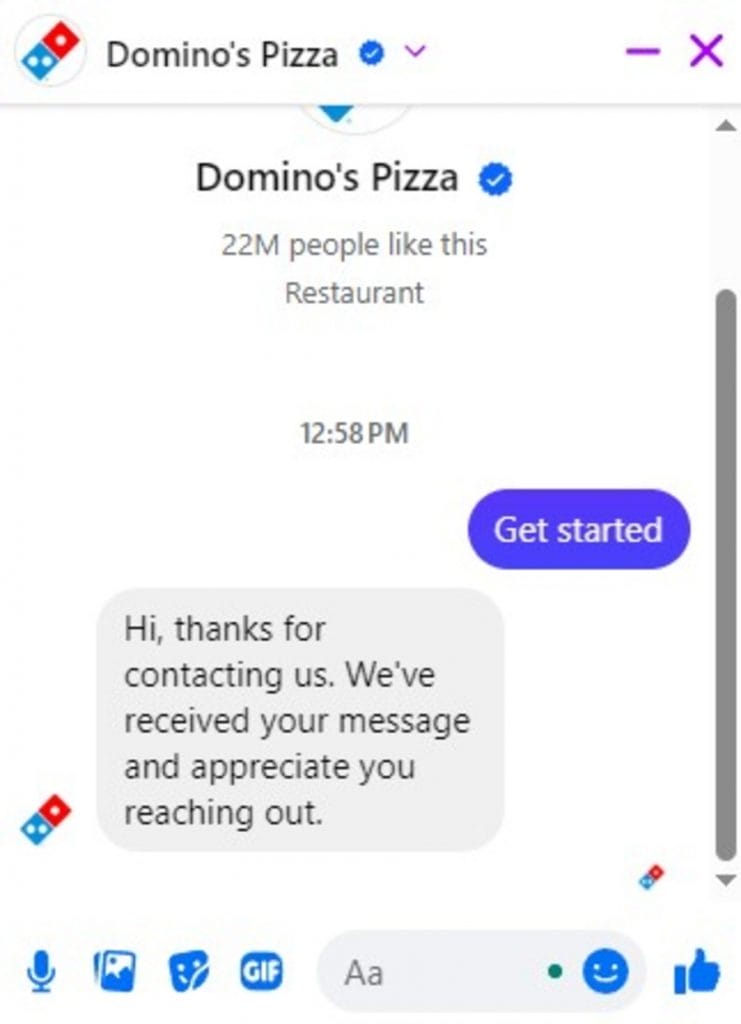
Its automated Messenger responses instantly acknowledge messages, set expectations and keep the conversation moving without delay.
The approach keeps service consistent and accessible, reflecting the company’s focus on convenience and efficiency.
9. Use Facebook Marketplace For Product Visibility
Among the most practical marketing strategies of Facebook marketplaces is recognizing its role as both an eCommerce and connection hub.
With Facebook leading social commerce and 24% of users using it for purchases, Marketplace connects businesses and service providers with people who are already in a buying mindset.
To make Marketplace work effectively for your business:
- Write clear, keyword-rich descriptions: Improve visibility and help listings appear in relevant searches.
- Use high-quality visuals: Showcase your product or service in real settings to build credibility.
- List available services: Offer options such as home repairs, cleaning or installations so customers can reach professionals directly.
- Link your listings to your catalog or booking system: Keep information consistent and make it easy for people to act.
- Run Marketplace-specific ads: Target users already browsing related items or services to increase engagement.
- Respond promptly: Quick, helpful replies through Messenger can turn interest into a confirmed purchase or booking.
Below, you’ll find an overview of the basic features of Facebook Marketplace:
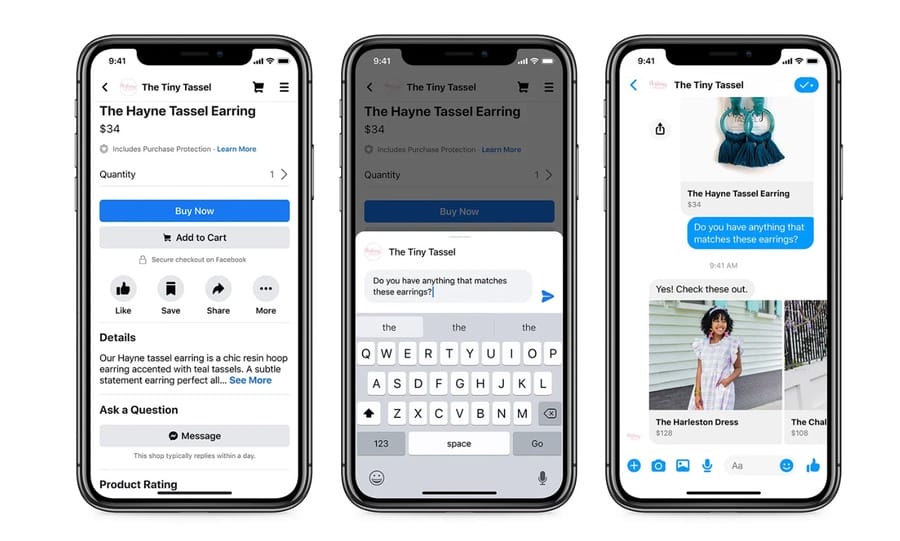
10. Run Contests And Giveaways
How many of us have been tagged in a giveaway by a friend and ended up scrolling through a brand’s page out of simple curiosity?
Contests capture attention in a way few other tactics do, sparking activity that feels organic and social rather than promotional.
On Facebook, giveaways work because they invite participation instead of asking for it.
People share, comment and tag friends, helping your content reach audiences you might never reach through ads alone.
To design contests that drive engagement and follow Facebook’s guidelines:
- Keep participation simple: Ask users to comment, share, or tag in a way that feels natural and quick.
- Offer prizes that align with your brand: Choose rewards that reinforce what your business represents.
- Be transparent: Clearly outline the rules, eligibility and end date for every campaign.
- Acknowledge platform policy: Include a note that Facebook isn’t connected to or endorsing the promotion.
- Encourage genuine interaction: Ask for real opinions, experiences, or photos instead of empty tags.
- Announce results publicly: Share the winners and thank participants to show authenticity and follow-through.
For example, Soma Intimates uses giveaways on Facebook to promote its products in a way that feels personal and experience-driven.
By asking followers to tag friends and engage directly in the comments, the brand expands visibility through authentic social interaction while keeping entry simple.
11. Opt For Affiliate Marketing
Affiliate marketing on Facebook links exposure to real results through the platform’s scale and targeting accuracy.
U.S. affiliate marketing spending is expected to reach $15.8 billion by 2028, showing how brands are using partnerships to drive measurable sales growth.
The most effective Facebook affiliate marketing strategies focus on authenticity, combining relatable stories, product context and value-focused content that feels natural to the platform.
With direct affiliate links and built-in analytics, Facebook helps brands guide users from interest to action with minimal friction.
To maximize performance and sustain engagement:
- Choose affiliates that align with your brand values and audience: Authenticity drives conversions more effectively than reach alone.
- Focus on content that informs or demonstrates: Tutorials, product demos and testimonials perform better than pure promotion.
- Diversify placements: Test affiliate content across Pages, Reels, Groups and Lives to find where engagement peaks.
- Support affiliates with creative assets and tracking tools: Provide branded visuals, links with UTM parameters and clear messaging.
- Disclose transparently: Clear labeling builds trust and ensures compliance with Facebook’s and FTC’s guidelines.
Glossier relies on a network of creators who share honest product experiences across Facebook and other social platforms, often tagging their posts with #GlossierAffiliate to disclose partnerships transparently.
These posts highlight real users and authentic moments rather than polished ads, which supports the brand’s credibility and drives engagement.
12. Tag Products In Facebook Posts And Photos
58% of U.S. shoppers say they’ve bought a product after discovering it on social media.
For brands using Facebook, tagging products in posts and photos turns awareness into action by allowing users to explore or purchase items directly from what captures their attention.
Each tagged image acts as both storytelling and storefront. Instead of interrupting the browsing experience, it integrates commerce naturally into content, shortening the path between interest and transaction.
To apply this Facebook marketing strategy effectively:
- Show products in context: Use lifestyle imagery that demonstrates how each item fits into real use.
- Add direct prompts to explore: Encourage clicks through clear captions or subtle cues without overselling.
- Maintain visual consistency: Keep your color, tone and framing aligned with your broader brand identity.
- Group complementary items: Tag related products together to increase engagement and average order value.
Among retail brands using Facebook’s shopping tools, PinkTag shows how product tagging can feel both natural and effective.
Their “Chic Girly Gift Guide” post invites shoppers to explore items directly through the “Click to view products” feature, turning a visual collage into a shoppable experience.
Each tag links to specific products, so customers can easily browse and buy with a few simple clicks.
13. Contribute To A Greater Cause
With 73% of consumers believing brands should act now for the good of society and the planet, purpose is no longer a secondary message, as it becomes part of the brand’s value proposition.
On Facebook, where people connect around shared interests and ideals, socially conscious storytelling can create the kind of trust and relatability that traditional advertising rarely achieves.
When businesses use their platform to advance causes that align with their principles and audience values, they position themselves as participants in progress rather than mere observers.
Ways to turn purpose into meaningful engagement:
- Support causes that connect to your brand’s core mission: Authenticity matters more than scale; the initiatives that resonate most are those rooted in genuine relevance.
- Partner with organizations driving measurable community impact: Strategic collaborations lend credibility and help translate intent into tangible results.
- Show accountability through transparency: Use updates, testimonials or data to communicate progress rather than promises.
- Invite your audience into the effort: Campaigns that encourage collective participation, such as through donations, education or action, build loyalty grounded in shared values.
- Make purpose a consistent narrative: Integrate it into everyday communication so it feels inherent to your brand identity, not an occasional marketing theme.
For instance, MeUndies partnered with the National Breast Cancer Foundation to link customer donations with real-world outcomes, offering both support for patients and an incentive for participation.
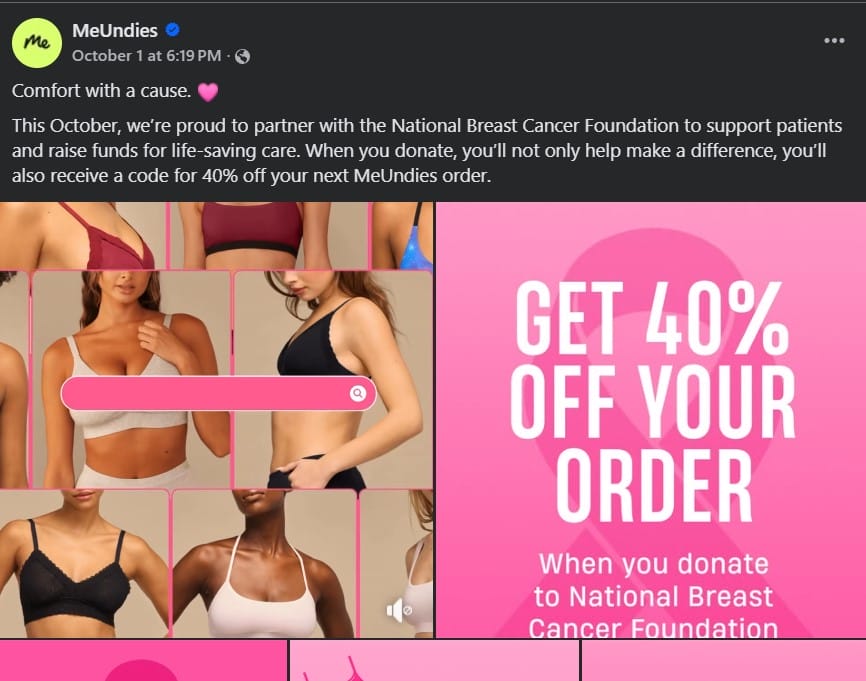
This approach demonstrates how aligning a brand with meaningful causes can deepen connection and inspire action without losing commercial focus.
14. Create A Signature Group
90% of consumers use social media to stay informed about trends and cultural moments, which is exactly why Facebook Groups work so well for building community.
People naturally seek spaces where they can exchange ideas, share discoveries and connect with others who follow the same interests.
Within that context, the most effective Facebook group marketing strategies focus on creating value through shared learning and dialogue rather than broadcasting updates.
Ways to build a meaningful group experience:
- Define a purpose that adds value: Center the group around expertise, shared goals or insider insights to make every interaction worthwhile.
- Encourage discussion and collaboration: Let members guide the conversation through questions, experiences and peer feedback.
- Offer exclusive access and participation: Use the group to share early updates, invite feedback on new initiatives or host private sessions.
- Engage as part of the community: Participate in discussions and offer perspective instead of leading with promotion.
- Keep content relevant and insightful: Share data, research or emerging trends that help members stay informed and connected.
Instant Pot’s Facebook Community is one of the largest branded groups online, with over 3 million members sharing recipes, tips and experiences.
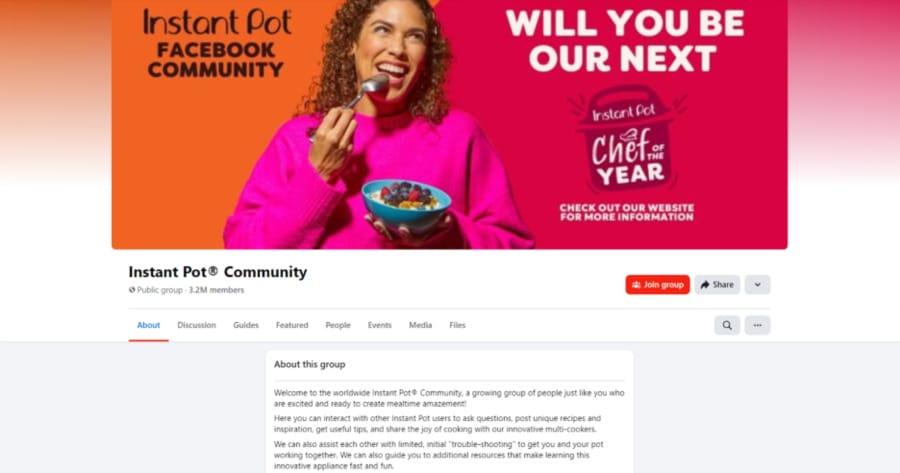
The group’s purpose is clear, as it helps people cook better and enjoy the process and invites members to ask questions, troubleshoot issues and exchange ideas that improve everyday cooking.
What makes it effective is how the company participates as a fellow enthusiast rather than a promoter, creating a sense of shared discovery that keeps the group active and authentic.
15. Use Facebook Pixel
Understanding what happens after someone clicks your ad is where real optimization begins.
Facebook Pixel is a small piece of code that links your website activity to your ad performance.
It tracks actions like views, clicks, sign-ups and purchases, revealing what people do after they engage with your campaigns.
How to apply it effectively:
- Track meaningful actions: Monitor events like “ViewContent,” “Add to Cart,” and “Purchase” to understand what drives conversions and long-term value.
- Build relevant audiences: Retarget visitors who browsed but didn’t buy or create lookalike audiences modeled on your most engaged customers.
- Optimize delivery: Use event data to guide automated bidding and show ads to people most likely to take valuable actions.
- Refine creative and strategy: Identify which messages and visuals convert best, using those insights to improve your next campaign.
Digital Silk’s Facebook Marketing Strategy Example
Digital Silk redefined Laser By Aleya’s Meta Ads strategy to attract and convert high-intent local audiences.
The campaign centered on women aged 25–45 in Great Neck, pairing precise targeting with messaging that emphasized real benefits like lasting skin confidence and long-term savings.
Each post was designed to feel personal and relevant, aligning service value with lifestyle aspirations.
The result was a 27% reduction in cost-per-lead and a consistent pipeline of qualified clients that supported ongoing growth.
Facebook Marketing Strategies For Nonprofits
While the general strategies apply to everyone, execution differs by sector. Nonprofits optimize for trust, impact and recurring giving rather than pure reach or ROAS.
The tactics below adapt Facebook fundamentals to mission goals, donor journeys and community building:
- Story over stats: Lead with founder snippets and beneficiary stories in 30–60 second vertical videos with a single CTA (donate or volunteer). Open with a 3–5 second hook, add captions, frame one person with one problem and one outcome, then save top clips as Reels and pin them.
- Low-friction giving: Enable the Donate button and birthday fundraisers. Pin a recurring-giving explainer, keep the donation page mobile-first with minimal fields and add a “what your $10 per month does” graphic to speed decisions.
- Community first: Create a private supporter group and host monthly impact AMAs with program leads. Seed weekly prompts like wins, behind-the-scenes notes and volunteer shout-outs, set clear group rules, and assign a moderator to welcome newcomers.
- Donation sequences: Retarget video viewers and page engagers in a simple three-step flow that starts with an impact video, follows with a testimonial carousel and finishes with a direct appeal. Schedule the steps over 7 to 14 days, set frequency caps, use consistent headlines, and add UTMs for clarity.
- Measurement: Track cost per donor, recurring rate, and 90-day retention instead of focusing only on CPM. Add average gift, view-through conversions and comment sentiment to a weekly dashboard, and run monthly creative lift tests with cohort analysis.
Facebook Real Estate Marketing Strategies
Here are practical tactics real estate teams can use on Facebook to move people from discovery to booked viewings.
- Local proof: Publish short Reels with neighborhood walk-throughs, “three things buyers ask in [Area]” and a weekly new-listing roundup. Add captions and location tags so content surfaces in local discovery.
- Lead magnets: Offer a “Neighborhood pricing guide” or “7-day move-in checklist” gated with Lead Ads, then route completions to Messenger for a friendly follow-up and pre-qualification.
- Speed to lead: Set an automatic Messenger reply that proposes viewing slots and integrates with your calendar so prospects can self-book immediately.
- Retargeting: Build audiences from people who watched at least 50% of a listing video and show them a carousel highlighting the property with a “Book a viewing” CTA, while excluding leads already contacted to prevent fatigue.
- Measurement: Prioritize cost per qualified showing and offer rate over generic leads and review channel-by-listing performance weekly to reallocate budget toward neighborhoods and formats that convert.
Fitness Marketing Strategies for Facebook
Below are Facebook plays tuned for gyms and studios, focused on time-bound challenges, tangible proof and member-driven strategies:
- Program arcs: Run four-week challenges with a weekly Live Q&A to keep momentum. Publish transformation Reels using consented client clips and caption them with the exact plan followed.
- Offers that convert: Use a free class or week-pass Lead Ad to capture interest, follow up in Messenger with a short nurture sequence and present a limited-time membership offer before the pass expires.
- UGC flywheel: Post member spotlights and group leaderboard screenshots to normalize participation. Invite members to share progress updates and reshare the best ones to your Page and Stories.
- Measurement: Track trial-to-member conversion, churn within 60 days and referrals generated per campaign. Review by program type to double down on formats that create sticky habits.
Facebook Network Marketing Strategies
Facebook network marketing is building a personal brand and community on the platform to drive word-of-mouth sales through direct conversations, transparent recommendations and small interactive events rather than mass blasting. Some common strategies include:
- Personal brand first: Share short educational posts and show the product in everyday context, avoid mass invites, and focus each post on one specific problem.
- Ethical disclosures: Use clear #ad or #affiliate on promotional content, explain why you chose the product, and show how you use it to build long-term trust.
- Micro-events: Host private group demos and short Lives with open Q&A and a pinned offer, collect questions in advance, and follow up with a simple recap and next steps.
- Measurement: Track conversations started, qualified call bookings, and repeat purchase rate, review weekly to see which topics spark replies and invest in those themes.
Facebook Marketing Strategies For B2B Companies
Below, you’ll find Facebook marketing strategies for B2B teams that turn subject-matter expertise into pipeline with problem-led content, value-first lead capture, light ABM targeting and revenue-focused measurement.
- Problem-led content: Publish pain-point carousels, before and after workflows and short case snippets. Name the buyer role in the hook, show a three-step fix, add one credible metric and end with a practical next step.
- Lead engines: Offer ungated value like checklists and calculators, then run retargeted Lead Ads for deeper assets such as RFP templates and ROI sheets. Deliver instantly, set expectations on follow-up and route to sales with context.
- ABM light: Build custom lists by domain and personalize creative by industry with relevant proof points. Sync audiences from your CRM, exclude current customers and use UTMs that capture account and industry.
- Measurement: Optimize for MQL quality, pipeline influenced and opportunity creation rather than raw form fills. Track meeting rate from leads, sourced versus influenced revenue and changes in sales cycle length.
Best Practices For Marketing Strategies On Facebook
Even the best Facebook marketing strategies can fall flat without proper execution.
To get the most out of your efforts, it’s important to follow a few key best practices that ensure consistency, credibility and long-term engagement:
- Don’t overwhelm followers with every post: Focus on delivering meaningful content, not just frequent updates. Posting too often can lead to lower engagement and follower fatigue.
- Monitor and respond to engagement: Replying to comments and messages shows that your brand is attentive and approachable. Address negative feedback tactfully and quickly to protect your reputation.
- Stay consistent with branding and tone: Use the same voice, color palette and style across posts to reinforce brand recognition. A unified look builds trust and professionalism.
- Avoid clickbait or misleading content: Misleading headlines may boost short-term clicks but harm credibility in the long run. Ensure your content delivers on its promises and follows Facebook’s content policies.
- Stay up-to-date on Facebook’s algorithm updates: The platform’s rules are always evolving and so should your strategy. Regularly check Meta’s official blog or trusted marketing sources to stay ahead.
Tools To Supercharge Your Facebook Marketing
Running an effective Facebook strategy takes more than creativity.
The right tools simplify execution, uncover insights and make every campaign easier to scale:
- Facebook Business Suite: A centralized hub for managing everything from posts and messages to ad campaigns. It allows teams to schedule content, monitor analytics, and respond to engagement in one streamlined dashboard.
- Meta Ads Library: A public database where you can explore active ads across Facebook and Instagram. It’s useful for analyzing competitor campaigns, tracking industry trends, and discovering creative formats that perform well.
- Third-party tools: Platforms like Buffer and Hootsuite simplify scheduling and performance tracking, while ManyChat automates customer interactions. Canva helps create high-quality visuals that align with your brand’s tone and messaging.
Create A Facebook Marketing Strategy With Digital Silk
An effective Facebook strategy depends on how well a brand understands its audience and applies that insight with intention.
The goal is to build a system where engagement drives learning and each campaign informs smarter decisions over time.
Digital Silk optimizes every stage of that process, combining creative execution, audience targeting and data insight to help brands turn Facebook into a steady source of growth and measurable impact.
As a professional digital marketing agency, our services include:
Contact our team, call us at (800) 206-9413 or fill in the Request a Quote form below to schedule a consultation.
"*" indicates required fields


